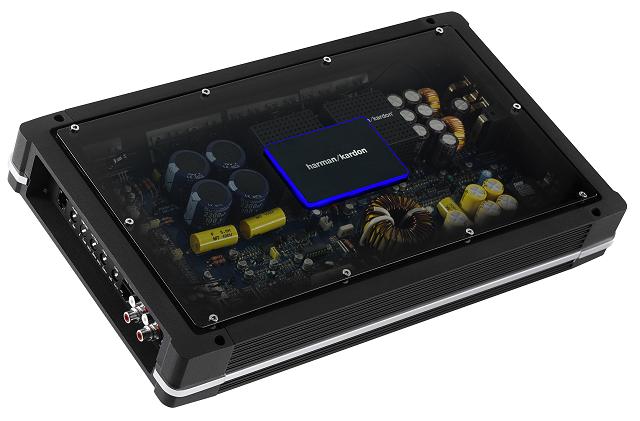Harman Kardon CA470
Four channel amplifier with smoked transparent plastic top panel and backlit logo panel on the centre. Weighty and well put together, you can see the neatly laid out SMD components within and the product is held together with quality Allen headed engineering screws/bolts. A subsonic filter is unusual at the price point and it can be set from 10Hz up to 80Hz so could be useful to bandpass a decent midbass system’s output. At time of writing the Input Management System sockets do not yet have the accessories available to connect with in the UK market but we gather are about higher levels of control of the amplifier plus the ability to daisy chain products by use of the RJ45 Ethernet cable/socket standard. The power ratings adhere to the USA’s Consumer Electronics Association (CEA) standardisation of output rating method created in 2006, so the output can be relied upon as factual. The chromed trim piece around the outside edge and the Chrome plated Allen headed bolts in the top panel make for a very attractive product.
– Class AB
– 4 x 85w RMS @ 4 Ohms (CEA-2006 Compliant)
– 4 x 135w RMS @ 2 Ohms
– 2 x 270w RMS @ 4 Ohms bridged
– Extruded Aluminium heatsink with cast end pieces and clear top plate blue backlit logo panel
– 8Ga. power terminals with Allen headed grub screw connection
– 4Ch RCA input and 2Ch RCA output
– 12dB per Octave high/low pass crossovers 32Hz to 320Hz
– Subsonic filter variable 12dB per Octave 10Hz to 80Hz
– Proprietary Input Management System sockets in & out on RJ45 Ethernet cable connectors
– Input sensitivity: not quoted but they do explain how to set it in the manual sheet
– Stereo & bridged operation
– Frequency response 10Hz to 100kHz
– Signal to Noise Ratio 104dB
– Channel separation not quoted
– Fuse Rating 20A x 3
– HxWxD(mm) 62 x 404 x 234mm
– Complete with two Allen wrenches long screws and three spare fuses
Review by Adam Rayner
Very rarely in this game do we get truly hot anticipation and yet this product garnered just that. Using the same tamper-proof shrink wrapping that the Rockford Fosgate folks have been utilising for a while, it comes out of the box tightly sealed. Opening it is thus like cracking the surface of a new jar of Marmite, or starting the jam. You know you are the first. I even referred to the thing’s virginity in the video I made before all these tests were done, (‘pop its cherry’) as I knew it was something you guys wanted to see.
Truly beautifully put together, it looks good whether it is on or not. Like a truly gorgeous car at standstill. (The BMW M1 Hommage story broke on the day of writing this!) However, once fired up, the logo panel in the middle of the clear smoky top lights up in the totally groovy edge-lit blue plot.
Little things impress. Like the neatly cocked terminal blocks, which are at a 45 degree angle. It makes no difference to constructional complexity apart from the first tooling of course and offers the user a far more friendly method of access. The Allen keys are supplied and although I use hex-head bits for everything, those using the supplied keys will find the operation of the terminals neater and tighter.
The whole feel of the product is of being better engineered and so while the Massive was all about meat and proven tech (very American car that) this HK is all about hanging ten over the techno wave. There are a couple of Ethernet-style sockets, one marked in and one marked out which are for some further sophisticated control accessories yet to be released. I guess we’ll just have to come in and edit when they are, so as to let you know what they are and do. One FAT advantage of internet publishing
As the tunes flowed, it revealed itself to be a brutally powerful thing, raising some 0.3dB more than the Massive P400.4 at 127.2dB. This was measured on the AudioControl SA-3055 RTA/SPL meter using a tripod on a window-sill and full range music, cranked until the beginning of audible stress to the signal. Then turned back just until distortion is no longer apparent before taking a peak-hold reading.
A big bold sound with tremendous drive and power is what is says in my notes, along with ‘Good explosive fronts to the bass.’ Which is all about that first wave front. A speaker has to copy the air-belting a drum’s skin gives to the space around it. A snare drum hit is so fast in rise time it is a challenge to a HiFi system. Second only to one played with brushes. This amp loved it and can slap your emotions with the accuracy of its bass delivery. At one point I even managed to create a moment’s distress from the otherwise imperturbable Morel components I was using as part of the test rig. It looks like the CEA rating has teeth as this is clearly more meaty than one or two amps in this group who are claiming 4x100w.
As far as that old Joy of Possession thing goes, this is way more than how much fun it is to open the box, it is about the whole package of looks, features, future technology upgrades and a kicking high quality sound and makes this a profoundly desirable item. The combination of excellent and tremendously flexible crossovers that enable use as either a subsonic or else as a bandpass assist device along with the top end build and finally with such a damn keen price makes it score enough to earn a well deserved Talk Audio Recommended flag.
Overall 9.0
Sound Quality 8
Power Output 10
Features 9
Build Quality 9
Value For Money 9

